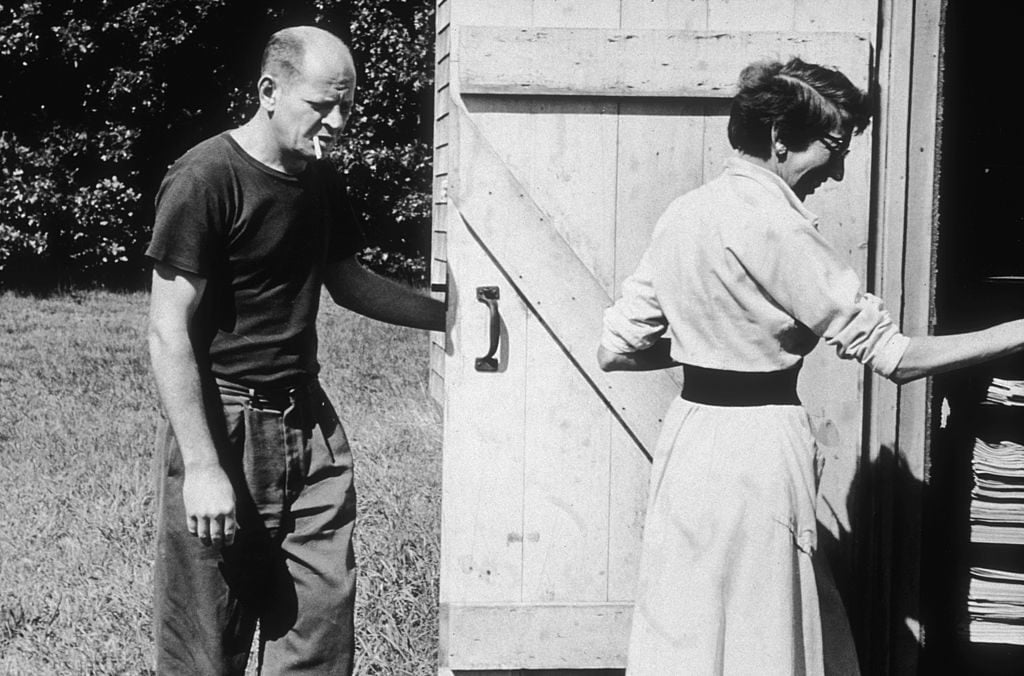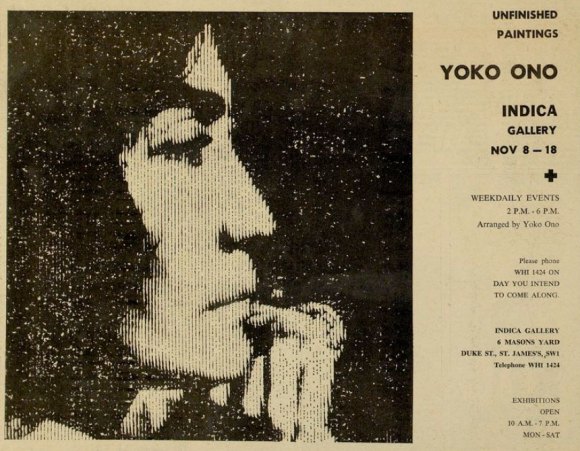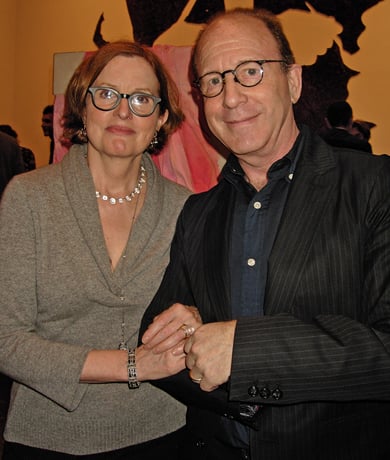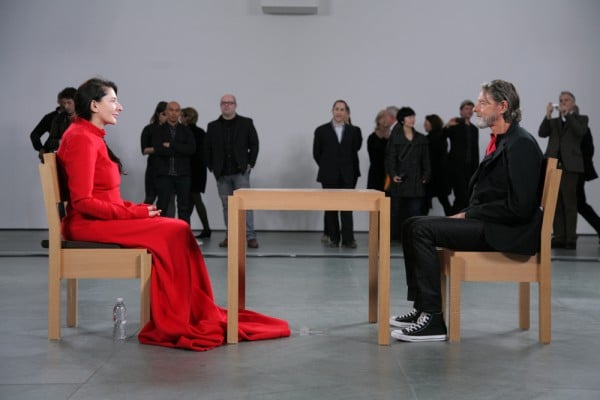People
How 8 Art World Power Couples Met and Fell In Love For Valentine’s Day
Whose first kiss was so busy that one of them chipped a tooth? Arty love secrets revealed.

Whose first kiss was so busy that one of them chipped a tooth? Arty love secrets revealed.

How did art world power couples meet and fall in love? Here are 8 stories for Valentine’s day. Truly hopeless romantics might also like to check out our related story The Best Romantic Artworks for Valentine’s Day.
John Currin and Rachel Feinstein
The pair met in a Manhattan art gallery where Feinstein was having a show. She was 23 and he was 32. Currin showed up at the behest of a mutual friend who wanted the pair to meet due to Feinstein’s uncanny resemblance to a girl who kept reappearing in Currin’s paintings. In a 2003 interview with the Guardian, he admits to being unsatisfied with his personal situation at the time: “I wanted to be a rich, famous artist and I wasn’t. I wanted to be in love with a wonderful woman and I wasn’t. So I had decided to give up and be promiscuous.” At the opening, Feinstein wore only white, with platinum blonde hair, cherry red lipstick, and shaved eyebrows. When she saw Currin, she walked up to him, planted a bright red kiss on his cheek and asked him out. He said he had other plans, but called her three days later with an invitation to come look at his paintings, which during her visit Feinstein turned her back to, preferring instead to just talk to him. Six months later the artists were ‘insanely in love’, and he was painting delightfully ethereal portraits of her. “I find the idea of a muse kinda corny,” he admits. “I think of the poet with a nude ghost in a Poussin picture. But when I met Rachel I felt that I could connect with some principles that moved my art along, that I had some freedom from the petty things in my own personality.”
Jackson Pollock and Lee Krasner
Krasner and Pollock’s relationship has been recounted several times in biographical writing, film, and folklore, but the occasion of their meeting is a particularly jaw-dropping detail. According to Henry Adams’s Tom and Jack: The Intertwined Lives of Thomas Hart Benton and Jackson Pollock, when the pair first crossed paths at an Artists Union dance in 1936, an intoxicated Pollock cut in on Krasner’s dance with another man. His drunken first words to her were “Do you like to fuck?” Artist Axel Horn recalls that this was typical behavior for Pollock around that time: “He would start chasing women, he would throw things around, yelling and challenging everybody.” She was not immediately smitten, for obvious reasons, but they met again when both were about to be featured in the same group show in 1942. They quickly became a couple and married three years later.

An announcement for Yoko Ono’s art show at Indica Gallery, where she met John Lennon.
John Lennon and Yoko Ono
The multimedia artist and her late rock icon husband met at Indica Gallery, a hip art space in the bottom of Indica Bookshop in Mayfair, London, that was owned by John Dunbar, Peter Asher, and Barry Miles, and supported in its early years by Paul McCartney. In a 1975 Rolling Stone interview with Jann Wenner, the Beatle recalls their meeting at the opening of one of Ono’s solo shows, where he was immediately taken with her conceptual style: “There was an apple on sale there for two hundred quid; I thought it was fantastic—I got the humor in her work immediately. I didn’t have to have much knowledge about avant-garde or underground art, the humor got me straightaway. There was a fresh apple on a stand—this was before Apple [the record label founded by the Beatles]—and it was two hundred quid to watch the apple decompose. But there was another piece that really decided me for-or-against the artist: a ladder which led to a painting which was hung on the ceiling. It looked like a black canvas with a chain with a spyglass hanging on the end of it. This was near the door when you went in. I climbed the ladder, you look through the spyglass and in tiny little letters it says ‘yes’. So it was positive. I felt relieved. It’s a great relief when you get up the ladder and you look through the spyglass and it doesn’t say ‘no’ or ‘fuck you’ or something, it said ‘yes.'” Interestingly, Ono had no idea who Lennon was, but Dunbar encouraged her to introduce herself to him, hoping he might purchase some art.

Roberta Smith and Jerry Saltz
Photo: Mary Barone/artnet Magazine
Jerry Saltz and Roberta Smith
New York’s star art critics weren’t always a package deal—or star art critics, for that matter. They met in 1986 when both were trying to make ends meet and Saltz was working on Beyond Boundaries: New York’s New Art (a book he clearly is not proud of, claiming to have attempted to “buy up and destroy every copy”). Without ever having met Smith or even read her work, he asked her to do an essay for it. “I never read her writing. I heard she had been fired from The Village Voice. Everybody loved Roberta so much. They said, ‘Oh, she’s so great, she’s so smart.’ And I thought, ‘Well, that’s who I should definitely get,'” he told Interview. “I think we were at a reception at the Canadian Consulate for [Eric] Fischl,” Smith recalled. “Jerry just kind of popped up and said, ‘Would you do this?’ And I said, ‘Let’s talk about it,’ because I was desperate for work.” The pair were married in 1992 at the home of fellow art world couple Carroll Dunham and Laurie Simmons, according to a New York Times announcement.
Jasper Johns and Robert Rauschenberg
The artists dated for six years in the 1950s and parted ways in 1961, an event which caused them both to leave New York City, radically alter their painting styles, and not see or speak to each other for at least a decade. According to Jonathan Katz’s chapter “The Art of Code” from Significant Others: Creativity and Intimate Partnership as reprinted on Queer Arts, they initially met through the artist and art writer Suzi Gablik, a mutual friend who had known Rauschenberg in graduate school. When they crossed paths again at an artist’s party, the pair struck up a friendship. Rauschenberg, who was five years Johns’s senior, convinced him to quit his job at a bookstore and join him in doing window designs for department stores. Rauschenberg was also responsible for introducing Johns to Leo Castelli, who gave him his first solo show. “He and I were each other’s first serious critics,” Rauschenberg said of Johns. “Actually, he was the first painter I ever shared ideas with, or had discussions with about painting…Jasper and I literally traded ideas. He would say, ‘I’ve got a terrific idea for you,’ and then I’d have to find one for him.”
Sharing a partnership in both life and art until her death in 2009, the pair met in Paris when they were both 23 (in a strange twist of fate, they were born on the same date—June 13, 1935). According to the Wall Street Journal, Christo was, in his wife’s words, “a penniless Bulgarian painter” at the time and had been commissioned to make a portrait of her mother, the wife of an influential general. “I was mean to him because I was attracted to him,” she admitted. “She was very intense—when she walked in, everyone knew that she was there. She was also very direct. She was absolutely uninterested in small talk. I wanted to know her better, so I thought, ‘What should I do to make her laugh?’ There was an avant-garde theater playing Ionesco, so I bought tickets in the front row,” Christo recalls. During the performance, Jeanne-Claude laughed so loudly and so hard that the actors had to stop to laugh with her. And their first kiss was so ardent, Christo chipped a tooth.

Marina Abramović and Ulay at the MoMA.
Photo: Scott Rudd, 2010
Marina Abramović and Ulay
Abramović and Ulay (whose given name is Uwe Laysiepen) also share the same birthday, though theirs are three years apart. The performance artists actually met on their shared birthday in Amsterdam in 1975 when Abramović was invited to do a television program about body art, and a gallerist asked Ulay to retrieve her from the airport. In the documentary film Marina Abramović: The Artist is Present, she says: “There was immediately a fascination…like we have found a lost brother or lost sister…I loved him more than I loved myself.” The pair created over 90 works of performance art together during the 12 years they were a couple. In 1988, they broke up through the act of standing on opposite sides of the Great Wall of China, walking towards each other, and meeting in the middle to say goodbye. She claims to have conceived of this act in a dream. “Each of us walked two and half thousand kilometers to meet in the middle and depart from each other and continue working as a single artist,” she said in a release for her show at the Garage Center for Contemporary Culture. “It was very dramatic and a very painful ending.” During Abramović’s performance of The Artist is Present at her 2010 MoMA retrospective, Ulay came and sat down across from her, provoking a highly emotional response both from Abramović and onlookers.
Alfred Stieglitz and Georgia O’Keeffe
When the two now-legendary artists met in 1916, Stieglitz, at 52, was an internationally acclaimed photographer and gallerist, while O’Keeffe was just 28 and a complete unknown. “Stieglitz was the most important person in the New York art world, and O’Keeffe was a schoolteacher,” Sarah Greenough, head of the photography department at the National Gallery of Art and editor of My Faraway One, a book of the couple’s love letters, explained to NPR. Soon after meeting O’Keeffe, Stieglitz became obsessed with photographing her, shooting over 300 portraits between 1918 and 1937. He was married at the time, but after obtaining a divorce from his first wife, he and O’Keeffe wed in 1924. “Dearest Child — What do I want from you — You say I seem to need you — that you need me less than I need you — That’s true in a way — Still — it’s not entirely fair to me or to you,” Stieglitz wrote to her in a letter of May 1918. “Your living is important — that’s what I want — my living is really not important. — I am young in spirit — As a spirit of some use — Otherwise truly hopelessly unfit.”